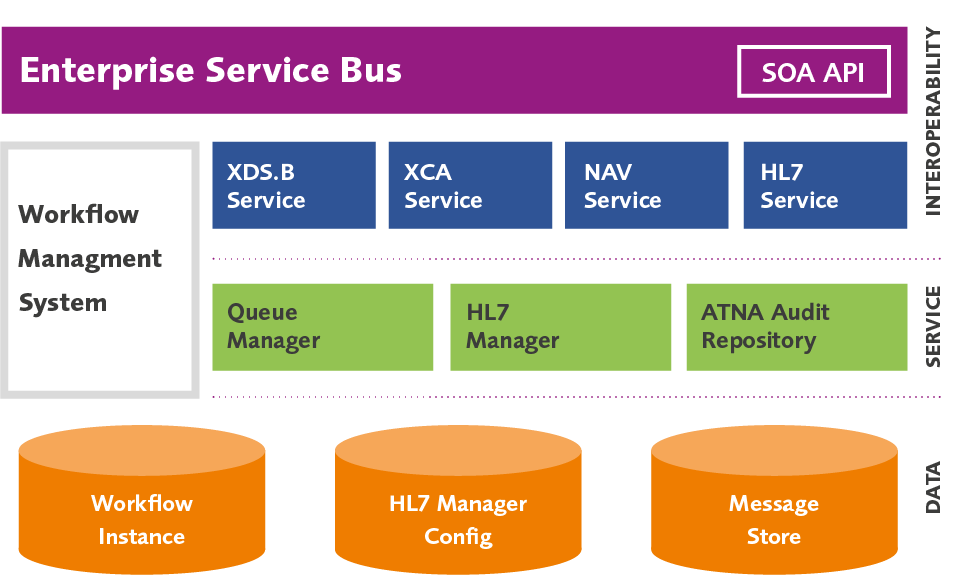
Interoperability

Interoperability and application cooperation for accessible and secure information
Interoperability is the ability of two or more systems to communicate with each other and exchange data efficiently and securely. In a world where technology has become an essential component of life, interoperability is one of the most important qualities a system must have.
Especially in Healthcare, interoperability is of fundamental importance, because it allows the synchronization and exchange of information for the management of patients, clinical data, or administrative practices.
Thanks to the interoperability between the different systems, healthcare professionals can receive and share timely, updated, and accurate information.
Interoperability between healthcare systems helps reduce waiting times and increases the quality of care.
IE-Middleware: an integrated platform for interoperability
Information system architectures include an ever-increasing number of federated components and applications that exchange millions of messages, in hundreds of different formats.
IE-Middleware is a second-generation EAI (Enterprise Application Integration) that manages and guarantees the interoperability, integration, and application cooperation between heterogeneous systems, from an SOA (Service Oriented Architecture) perspective.
Middleware components act on 3 levels:
Interoperability contains all the components necessary for interfacing and integrating from and to any external system, displaying services of any type, both relating to legacy systems and implementing interfaces compatible with current standards (HL7, XDS.b, etc.).
The interfaces, validated and certified at the Connectathon, are perfectly compliant with the IHE specifications.
Service manages and guarantees the correct functioning of the entire IE-Middleware platform. Here the components for the management of HL7 messaging are implemented, those for managing the queues of processes to be executed, and the ATNA Repository for tracing all the managed transactions.
Data represents the persistence of information managed by IE-Middleware, which is saved on special schemas in the database.

The Workflow Management System is transversal, so as to interact directly with the ESB (Enterprise Service Bus) component or be used by all the components of the Services level.
Enterprise Service Bus
The decision to insert an Enterprise Service Bus tool is fundamental, given the multitude of elements inside the platform. ESB performs two fundamental tasks:
- guarantees a plug-in architecture for a “building block” type approach, without however introducing dependencies between the various components;
- simplifies integration with existing infrastructure.
SOA API
To define a well-structured SOA architecture, it is possible to redefine the APIs of the main services, directly within the ESB component, by creating simple flows and transformation rules.
XDS.b Service
With a view to centralized SOA API, IE-Middleware can expose various standard interfaces to forward messages to the appropriate systems. In particular, all XDS.b services and related IHE transactions can be exposed by IE-Middleware and linked to the registry and the corporate repository.
XCA Service
IE-Middleware can also fill the role of Gateway in the context of XCA integrations:
- outgoing, i.e. by locally exposing the transactions envisaged by the InitiatingGateway specifications and being able to communicate correctly with the various configured RespondingGateways;
- input, presenting itself to other HomeCommunities precisely as RespondingGateways and redirecting searches on the registry and the various internal repositories linked to IE-Middleware.
NAV Service
IE-Middleware implements IHE’s NAV (Notification of Document Availability) services, automatically, if connected to Gpi’s IE-Repository solution, or – if linked to another repository – as a communication channel for enveloping and sending notifications to the configured NotificationReceivers.
HL7 Service
IE-Middleware plays the role of collector of HL7 services that can be implemented within the platform or simply as a means of transport (with the definition of flow at the ESB level to route and convey the messages of interest). Also, in this case, the great advantage of conveying information via IE-Middleware is to intercept and trace all messages and active transactions on the various systems.
Queue Managers
The component dedicated to the management of activity queues is essential when there are a large number of processes and events. IE-Middleware includes the AMQP (Advanced Message Queuing Protocol) standard which allows applications from different places and with different languages to communicate quickly in an optimal way.
Atna Audit Repository
To centrally manage the various interactions, the architecture includes an Audit Trail service which takes care of recording each event and tracing its status. Recording communication activities is useful for the general improvement of performance and effectively contributes to the identification of problems between the various systems.
Authentication – To verify that the person making the request is who they say they are, identity can be ascertained via: user/password, digital certificate, SAML token or Kerberos.
Authorization or access control – To take advantage of resources or application components, based on the specific role.
Confidentiality and privacy – To keep information confidential, sensitive or particularly important data can be encrypted within messages, using the XML Encryption standard.
Integrity – To make sure messages remain unaltered as they travel across the network, they can be signed using the XML Signature standard.
All these requirements are respected by IE-Middleware through various standards, both at the transport level (e.g. Secure Socket Layer) and at the application level (e.g. XML).
